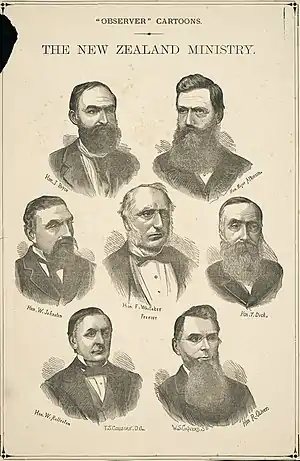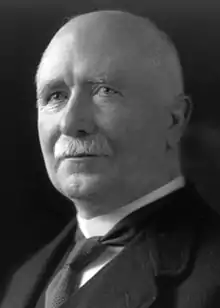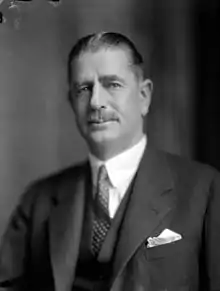Reform Party (New Zealand)
The Reform Party, formally the New Zealand Political Reform League, was New Zealand's second major political party, having been founded as a conservative response to the original Liberal Party. It was in government between 1912 and 1928, and later formed a coalition with the United Party (a remnant of the Liberals), and then merged with United to form the modern National Party.
Reform Party | |
|---|---|
| Founded | 11 February 1909 |
| Dissolved | 1936 |
| Merged into | National Party |
| Ideology | Conservatism |
| Political position | Centre-right |
| National affiliation | United/Reform Coalition (1931–36) |
Foundation

| This article is part of a series on |
| Conservatism in New Zealand |
|---|
 |
|
|
The Liberal Party, founded by John Ballance and fortified by Richard Seddon, was highly dominant in New Zealand politics at the beginning of the 20th century. The conservative opposition, consisting only of independents, was disorganised and demoralised. It had no cohesive plan to counter the Liberal Party's dominance, and could not always agree on a single leader — it was described by one historian as resembling a disparate band of guerrillas, and presented no credible threat to continued Liberal Party rule.
Gradually, however, the Liberals began to falter — the first blow came with the death of Richard Seddon, their popular leader, but other factors contributed to their decline. Importantly for conservatives, the Liberals were slowly losing support from small farmers, who had once backed the Liberals due to their promise of land reform. Having achieved the land reforms, farmers had little reason to continue their support for the Liberals, and drifted towards the socially conservative opposition. At the same time, the Liberals were also slowly losing their other base of support, the urban working class — the Ballance and Seddon governments had introduced many reformist labour laws, but under later leaders (notably Joseph Ward) the reforms had slowed. The Liberals were split between the farmers and the workers, attempting to please both and therefore satisfying neither. The attempts of the Liberals to win back the labour vote were decried by conservatives as "socialistic", and the flight of farmers and businessmen from the Liberal Party was accelerated. The conservative opposition, which pledged its opposition to the alleged socialist tendencies of the Liberals, was strengthened.
The foundation of the Reform Party was closely associated with this return of the opposition to political significance, and with growing agitation against the Liberal Party's alleged socialism. The party itself crystallised around a farmer-turned-politician named William Massey, who became the leader of most conservatives in Parliament in 1903 after serving many years prior as the conservative whip. Also closely linked to the group were the Political Reform League, Auckland's "National Association", and (in an unofficial capacity) the Farmers' Union. The opposition began referring to itself as the Reform Party in 1909, and adopted a common platform for contesting elections. Among the party's important policy planks were farmers' freehold and the reform of the public service.
Despite campaigning heavily against the government's "socialism", it did not propose to undo the Liberal Party's labour and welfare reforms. In 1911 a consistent theme of the Reform campaign was that it stood for "true Liberalism" and the Opposition accepted the permanency of the basic reforms of the Liberals in the 1890s. They claimed patronage, corruption and "Tammanyism" (patronage based on connections) for example in civil service appointments.[1]
Reform Government
In the 1911 elections, the Reform Party won thirty-seven seats compared with thirty-three for the Liberals. Supporters of the Liberals denied that Reform had won a mandate to rule, however, pointing out that the country quota (a system in which rural electorates were smaller than urban ones, meaning that rural areas were slightly over-represented in Parliament) worked to "inflate" Reform's vote. Nevertheless, it did not take long for the Liberal government, now ruling only with the support of independents, to fall. William Massey became Prime Minister on 10 July 1912.
In government, the Reform Party implemented many of its policies regarding freehold and public service reform. Many other Liberal-era policies were not changed, however, and Reform gained further support from disillusioned members of the Liberal Party. Reform also demonstrated its tough line against "socialism" with its responses to a number of notable strikes — the Waihi miners' strike, led by left-wing unions which Massey condemned as "enemies of order", was harshly suppressed, and one worker died. A dockworkers' strike in 1913 was also broken. The strikes prompted considerable concern about socialism in certain sectors of society, boosting Reform's results in the 1914 elections.
In the 1919 elections, Reform further strengthened its position, despite the emergence of a single united Labour Party. In the 1922 elections, however, the approach of depression cost the government considerably, and Reform was forced to build an unstable coalition of independents.
In 1925, Massey died. After a period under interim leader Francis Bell, Reform chose Gordon Coates as its new leader. Coates, while not regarded as politically astute, was relatively popular with the public, and campaigned well. In the 1925 elections, Reform won a surprisingly high number of seats — fifty-five, compared with twelve for Labour and eleven for the chaotic Liberals. This victory was not as pronounced in the statistics for the popular vote, however — many believed that Reform had profited from the three-party configuration, with the anti-Reform vote being split.
In the 1928 elections, however, there was a substantial reversal. The new United Party, founded on the ashes of the Liberal Party, experienced a surge of support, tying with Reform on twenty-seven seats. The Labour Party won nineteen seats. The Reform Party government was defeated by an alliance of United and Labour.
Opposition and Coalition
The Reform Party, still led by Coates, continued in opposition. The worsening economic situation left the United Party government struggling, and in 1931, the Labour Party withdrew its support in protest at certain economic measures. The Reform Party reluctantly agreed to support the United Party government, as the depression had raised fears of major gains for Labour if an election were held. United and Reform established a coalition government, with United's George Forbes remaining Prime Minister but Reform's Downie Stewart becoming Finance Minister.
In coalition, the two parties suffered only minor losses in the 1931 elections. As the depression failed to dissipate, however, the government became more and more unpopular, and support for the Labour Party soared. Clashes between Gordon Coates (who still led Reform) and Downie Stewart over economic policy eventually prompted Downie Stewart's resignation, earning the government a new critic and hurting its popularity still further. In addition, some of the coalition's measures to revive the economy were condemned by some as "socialist" — the Democrat Party, founded to fight this "socialism", cost the coalition a certain amount of support. In the 1935 elections, the coalition to suffered a massive defeat to the Labour Party, winning only nineteen seats to Labour's fifty-three.
Shortly after losing the 1935 elections, Reform and United resolved to merge completely, creating a united front against Labour. The new group was named the National Party, and has remained Labour's principal opponent ever since.
Parliamentary leaders
Key:
Reform
Liberal
United
Labour
PM: Prime Minister
LO: Leader of the Opposition
†: Died in office
| No. | Leader | Portrait | Term | Position | Prime Minister | |||
|---|---|---|---|---|---|---|---|---|
| 1 | William Massey |  |
February 1909 | 10 May 1925† | LO 1909–1912 | Ward | ||
| Mackenzie | ||||||||
| PM 1912–1925 | Massey | |||||||
| 2 | Francis Bell (interim) |
 |
14 May 1925 | 30 May 1925 | PM 1925 | Bell | ||
| 3 | Gordon Coates |  |
30 May 1925 | 13 May 1936 | PM 1925–1928 | Coates | ||
| LO 1928–1931 | Ward | |||||||
| Forbes | ||||||||
| Junior coalition partner in government 1931–1935 |
||||||||
| Junior coalition partner in opposition 1935–1936 |
Savage | |||||||
| Reform Party merged into National Party 1936. | ||||||||
Electoral results
| Part of a series on |
| Conservatism |
|---|
 |
|
| Election | # of votes | % of vote | # of seats won | Government/opposition? |
|---|---|---|---|---|
| 1911 | 159,309 | 33.37 | 37 / 80 | Government |
| 1914 | 243,025 | 47.1 | 40 / 80 | |
| 1919 | 193,676 | 35.7 | 43 / 80 | |
| 1922 | 249,735 | 39.35 | 37 / 80 | |
| 1925 | 324,239 | 47.18 | 55 / 80 | |
| 1928 | 271,259 | 35.87 | 28 / 80 | Opposition |
| 1931 | 190,170 | 26.6 | 28 / 80 | Government (coalition) |
| 1935 | 285,422† | 33.48† | 9 / 80 | Opposition |
†Total Coalition vote.
References
- Hamer 1988, pp. 329, 330.
Further reading
| Wikimedia Commons has media related to New Zealand Reform Party. |
- Bassett, Michael. Three Party Politics in New Zealand, 1911–1931 (Auckland: Historical Publications, 1982)
- Burdon, R. M. The New Dominion. A Social and Political History of New Zealand, 1918–1939 (Wellington: A. H. & A. W. Reed, 1965)
- Gardner, William James (1966), "MASSEY, William Ferguson", An Encyclopaedia of New Zealand, edited by A. H. McLintock, retrieved 24 April 2008
- Gardner, William J. "The Rise of W. F. Massey, 1891–1912", Political Science (March 1961) 13: 3–30; and "W. F. Massey in Power", Political Science (Sept. 1961), 3–30.
- Gustafson, Barry, "Massey, William Ferguson 1856–1925", Dictionary of New Zealand Biography, retrieved 24 April 2008
- Hamer, David (1988). The New Zealand Liberals: The Years of Power, 1891–1912. Auckland NZ: Auckland University Press. ISBN 1-86940-014-3.
- Watson, James, and Lachy Paterson, eds. A Great New Zealand Prime Minister? Reappraising William Ferguson Massey (2010), essays by scholars
- Fairburn, Miles; Haslett, Stephen (2005), "How far did class determine voting in New Zealand general elections 1911–1951?", New Zealand Journal of History, 39 (2): 215–241
- Hamer, David A. (1979), "Towns in nineteenth-century New Zealand", New Zealand Journal of History, 13 (1): 5–24
Contemporary sources
- Politics and reform: the situation in New Zealand to-day and the remedy, Wellington, [N.Z.]: Dominion, 1910
- General election campaign, 1914, Wellington, [N.Z.]: Ferguson & Osborn, Printers, 1914
- [William] Massey’s legislation for the masses: from official records : summary and comaprison. [sic], Wellington, [N.Z.]: Wellington Publishing Co., 1914
- The Huntly mining disaster: a conspiracy of misrepresentation: Minister of Mines maligned: un-British tactics exposed, Wellington, [N.Z.]: Ferguson & Osborn, Printers, 1915
- The general election campaign, 1919: record of Reform Party in connection with session of 1919 and other matters, Wellington, [N.Z.]: Ferguson & Osborn, Printers, 1919
- Reform’s record and achievements, 1912–1922, Wellington, [N.Z.]: Reform Party ; Ferguson & Osborn, Printers, 1922
- Campaign memoranda General Election, 1925, Wellington, [N.Z.]: Reform Party, 1925
- The candidate’s vade mecum, Wellington, [N.Z.]: Newsletter Office, 1925
- New Zealand Labour Party, Wellington, [N.Z.]: Reform Party (New Zealand), 1925 The N.Z. Labour Party’s land policy: its destructive effect on private ownership: how the "working farmer" would fare under socialism
- Stout, Robert (1910), University reform: demands of the Reform Party considered by the Chancellor, Dunedin, N.Z.: Evening Star, a lecture given by the chancellor of the University of New Zealand at Victoria University College on 30 June 1910.